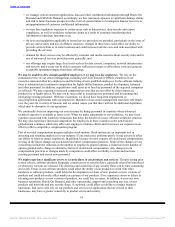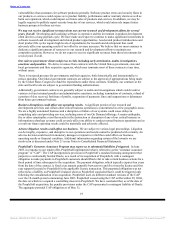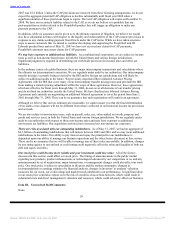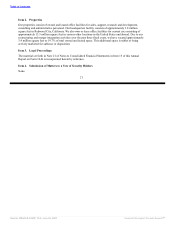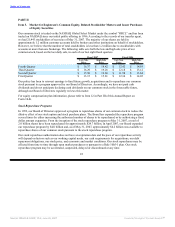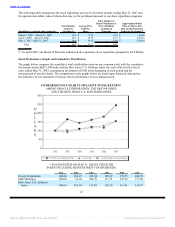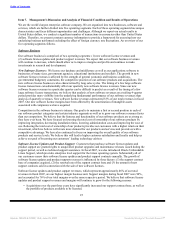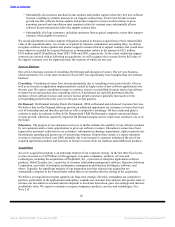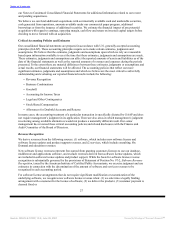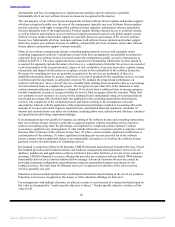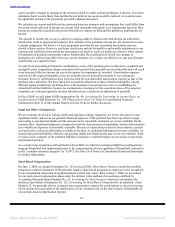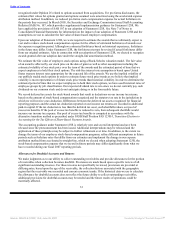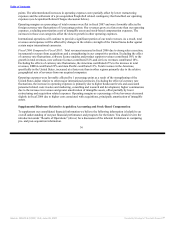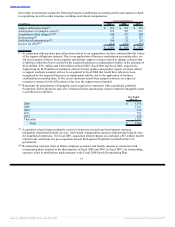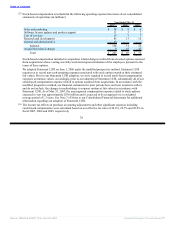Oracle 2006 Annual Report Download - page 32
Download and view the complete annual report
Please find page 32 of the 2006 Oracle annual report below. You can navigate through the pages in the report by either clicking on the pages listed below, or by using the keyword search tool below to find specific information within the annual report.
Table of Contents
determinable and free of contingencies or significant uncertainties; and (4) collection is probable.
Substantially all of our new software license revenues are recognized in this manner.
The vast majority of our software license arrangements include software license updates and product support,
which are recognized ratably over the term of the arrangement, typically one year. Software license updates
provide customers with rights to unspecified software product upgrades, maintenance releases and patches
released during the term of the support period. Product support includes internet access to technical content,
as well as internet and telephone access to technical support personnel located in our global support centers.
Software license updates and product support are generally priced as a percentage of the net new software
license fees. Substantially all of our customers purchase both software license updates and product support
when they acquire new software licenses. In addition, substantially all of our customers renew their software
license updates and product support contracts annually.
Many of our software arrangements include consulting implementation services sold separately under
consulting engagement contracts. Consulting revenues from these arrangements are generally accounted for
separately from new software license revenues because the arrangements qualify as service transactions as
defined in SOP 97-2. The more significant factors considered in determining whether the revenue should be
accounted for separately include the nature of services (i.e., consideration of whether the services are essential
to the functionality of the licensed product), degree of risk, availability of services from other vendors, timing
of payments and impact of milestones or acceptance criteria on the realizability of the software license fee.
Revenues for consulting services are generally recognized as the services are performed. If there is a
significant uncertainty about the project completion or receipt of payment for the consulting services, revenue
is deferred until the uncertainty is sufficiently resolved. We estimate the proportional performance on
contracts with fixed or “not to exceed” fees on a monthly basis utilizing hours incurred to date as a percentage
of total estimated hours to complete the project. We recognize no more than 90% of the milestone or total
contract amount until project acceptance is obtained. If we do not have a sufficient basis to measure progress
towards completion, revenue is recognized when we receive final acceptance from the customer. When total
cost estimates exceed revenues, we accrue for the estimated losses immediately using cost estimates that are
based upon an average fully burdened daily rate applicable to the consulting organization delivering the
services. The complexity of the estimation process and factors relating to the assumptions, risks and
uncertainties inherent with the application of the proportional performance method of accounting affects the
amounts of revenue and related expenses reported in our consolidated financial statements. A number of
internal and external factors can affect our estimates, including labor rates, utilization and efficiency variances
and specification and testing requirement changes.
If an arrangement does not qualify for separate accounting of the software license and consulting transactions,
then new software license revenue is generally recognized together with the consulting services based on
contract accounting using either the percentage-of-completion or completed-contract method. Contract
accounting is applied to any arrangements: (1) that include milestones or customer specific acceptance criteria
that may affect collection of the software license fees; (2) where services include significant modification or
customization of the software; (3) where significant consulting services are provided for in the software
license contract without additional charge or are substantially discounted; or (4) where the software license
payment is tied to the performance of consulting services.
On Demand is comprised of Oracle On Demand, CRM On Demand and Advanced Customer Services. Oracle
On Demand provides multi-featured software and hardware management and maintenance services for our
database, middleware and applications software at Oracle’s data center facilities or at a site of our customer’s
choosing. CRM On Demand is a service offering that provides our customers with our Siebel CRM software
functionality delivered via a hosted solution that we manage. Advanced Customer Services are earned by
providing customers configuration and performance analysis, personalized support and annual on-site
technical services. Revenue from On Demand services is recognized over the term of the service period,
which is generally one year.
Education revenues include instructor-led, media-based and internet-based training in the use of our products.
Education revenues are recognized as the classes or other education offerings are delivered.
For arrangements with multiple elements, we allocate revenue to each element of a transaction based upon its
fair value as determined by “vendor specific objective evidence.” Vendor specific objective evidence of fair
value for all
28
Source: ORACLE CORP, 10-K, June 29, 2007 Powered by Morningstar® Document Research℠


